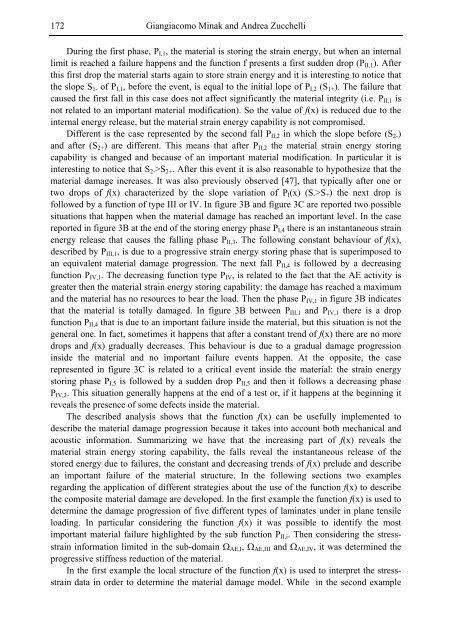Composite Materials Research Progress
Composite Materials Research Progress
Composite Materials Research Progress
Create successful ePaper yourself
Turn your PDF publications into a flip-book with our unique Google optimized e-Paper software.
172<br />
Giangiacomo Minak and Andrea Zucchelli<br />
During the first phase, PI,1, the material is storing the strain energy, but when an internal<br />
limit is reached a failure happens and the function f presents a first sudden drop (PII,1). After<br />
this first drop the material starts again to store strain energy and it is interesting to notice that<br />
the slope S1- of PI,1, before the event, is equal to the initial lope of PI,2 (S1+). The failure that<br />
caused the first fall in this case does not affect significantly the material integrity (i.e. PII,1 is<br />
not related to an important material modification). So the value of f(x) is reduced due to the<br />
internal energy release, but the material strain energy capability is not compromised.<br />
Different is the case represented by the second fall PII,2 in which the slope before (S2-)<br />
and after (S2+) are different. This means that after PII,2 the material strain energy storing<br />
capability is changed and because of an important material modification. In particular it is<br />
interesting to notice that S2->S2+. After this event it is also reasonable to hypothesize that the<br />
material damage increases. It was also previously observed [47], that typically after one or<br />
two drops of f(x) characterized by the slope variation of PI(x) (S->S+) the next drop is<br />
followed by a function of type III or IV. In figure 3B and figure 3C are reported two possible<br />
situations that happen when the material damage has reached an important level. In the case<br />
reported in figure 3B at the end of the storing energy phase PI,4 there is an instantaneous strain<br />
energy release that causes the falling phase PII,3. The following constant behaviour of f(x),<br />
described by PIII,1, is due to a progressive strain energy storing phase that is superimposed to<br />
an equivalent material damage progression. The next fall PII,4 is followed by a decreasing<br />
function PIV,1. The decreasing function type PIV, is related to the fact that the AE activity is<br />
greater then the material strain energy storing capability: the damage has reached a maximum<br />
and the material has no resources to bear the load. Then the phase PIV,1 in figure 3B indicates<br />
that the material is totally damaged. In figure 3B between PIII,1 and PIV,1 there is a drop<br />
function PII,4 that is due to an important failure inside the material, but this situation is not the<br />
general one. In fact, sometimes it happens that after a constant trend of f(x) there are no more<br />
drops and f(x) gradually decreases. This behaviour is due to a gradual damage progression<br />
inside the material and no important failure events happen. At the opposite, the case<br />
represented in figure 3C is related to a critical event inside the material: the strain energy<br />
storing phase PI,5 is followed by a sudden drop PII,5 and then it follows a decreasing phase<br />
PIV,2. This situation generally happens at the end of a test or, if it happens at the beginning it<br />
reveals the presence of some defects inside the material.<br />
The described analysis shows that the function f(x) can be usefully implemented to<br />
describe the material damage progression because it takes into account both mechanical and<br />
acoustic information. Summarizing we have that the increasing part of f(x) reveals the<br />
material strain energy storing capability, the falls reveal the instantaneous release of the<br />
stored energy due to failures, the constant and decreasing trends of f(x) prelude and describe<br />
an important failure of the material structure. In the following sections two examples<br />
regarding the application of different strategies about the use of the function f(x) to describe<br />
the composite material damage are developed. In the first example the function f(x) is used to<br />
determine the damage progression of five different types of laminates under in plane tensile<br />
loading. In particular considering the function f(x) it was possible to identify the most<br />
important material failure highlighted by the sub function PII,i. Then considering the stressstrain<br />
information limited in the sub-domain ΩAE,I, ΩAE,III and ΩAE,IV, it was determined the<br />
progressive stiffness reduction of the material.<br />
In the first example the local structure of the function f(x) is used to interpret the stressstrain<br />
data in order to determine the material damage model. While in the second example
















